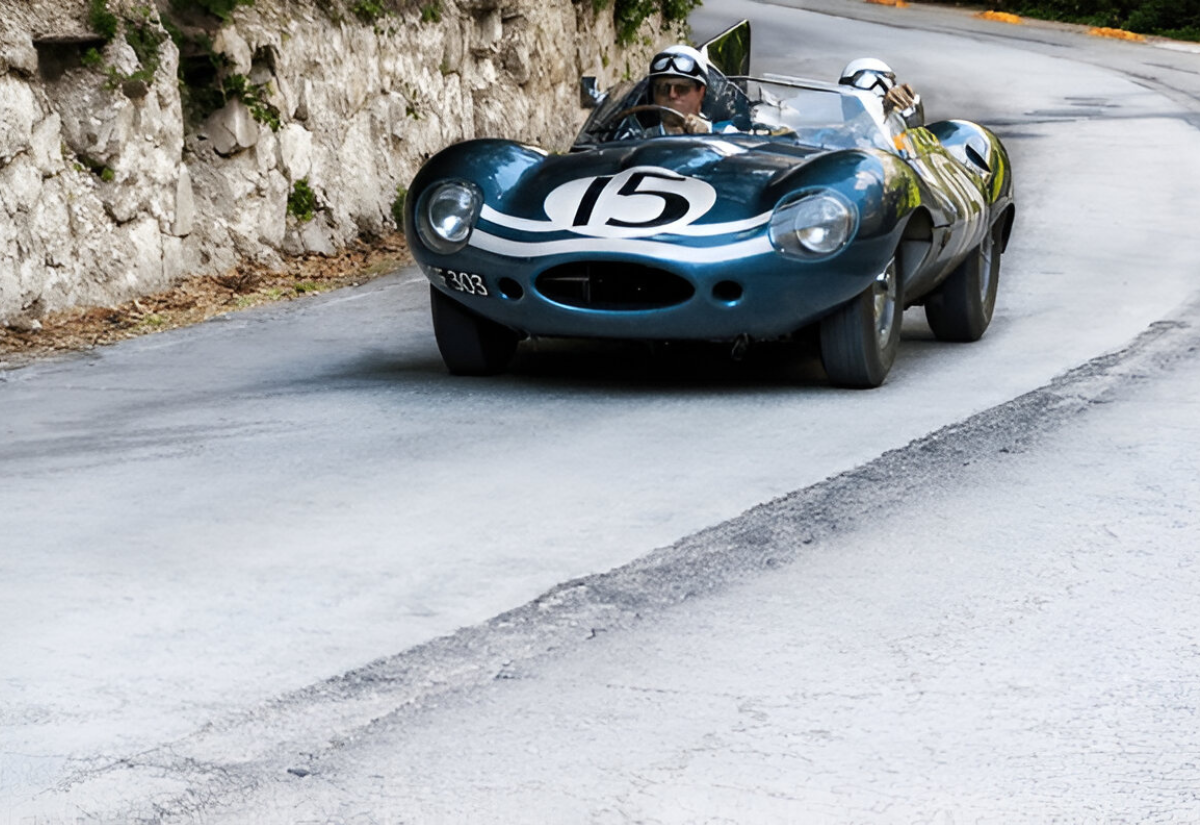Introduction
The Jaguar D-Type is more than just a car — it’s a symbol of speed, innovation, and timeless design. Built in the 1950s with racing glory in mind, it combined cutting-edge aerodynamics with Jaguar’s engineering expertise to dominate the world’s toughest endurance races. Today, the D-Type stands as one of the most admired and valuable classic cars ever made, remembered not only for its victories but also for its influence on automotive history.
The Origins of the Jaguar D Type
When Jaguar set out to design the D Type in the early 1950s, the company already had a strong reputation on the race track. Its predecessor, the C-Type, had brought Jaguar international success, including victories at the 24 Hours of Le Mans. But by mid-decade, advances in competition and aerodynamics meant Jaguar needed something new to stay ahead.
The D-Type was born from this challenge. Chief engineer William Heynes and aerodynamicist Malcolm Sayer played key roles in shaping the car’s future. Drawing on aircraft design principles from Sayer’s aviation background, the team created a racing machine unlike anything seen before.
Jaguar’s vision was clear: build a car that could dominate endurance racing with both speed and reliability. Every detail — from the lightweight monocoque construction to the sleek bodywork — reflected this focus. The result was a car that looked futuristic in its time and performed at a level that would redefine Jaguar’s place in motorsport history.
Distinctive Design and Engineering Innovations
One of the most striking features of the Jaguar D-Type was its futuristic appearance. The car’s sleek, aerodynamic body was sculpted to cut through the air with minimal resistance. Perhaps its most recognizable detail was the tall vertical fin rising behind the driver’s seat, a design choice that wasn’t just for style — it helped stabilize the car at high speeds, especially on the long straights of Le Mans. This distinctive silhouette made the D-Type instantly identifiable and set it apart from its rivals.
Beyond looks, the D-Type also introduced advanced engineering solutions. Jaguar pioneered the use of a lightweight aluminum monocoque chassis, a technique inspired by aircraft construction. This reduced weight while increasing structural rigidity, giving the car both strength and agility. The body panels, crafted with precision, wrapped around this innovative structure to create a blend of performance and durability.
The combination of aerodynamic refinement and cutting-edge materials allowed the D-Type to achieve speeds that few competitors could match in its era. It wasn’t simply a racing car — it was a forward-thinking engineering achievement that showcased Jaguar’s ability to innovate and push the boundaries of automotive design.
Racing Triumphs and Le Mans Legacy
The Jaguar D-Type cemented its reputation on the track, particularly at the 24 Hours of Le Mans, the most demanding endurance race in the world. From 1955 to 1957, the D-Type achieved three consecutive overall victories, an extraordinary feat that showcased both its engineering brilliance and reliability under extreme pressure. In 1957 alone, D-Types dominated the podium, finishing first, second, third, fourth, and sixth — a performance that remains one of the most memorable in motorsport history.
Behind these victories were some of the era’s most talented drivers. Names like Mike Hawthorn, Ivor Bueb, Ron Flockhart, and Ecurie Ecosse’s team of skilled racers brought out the best in the D-Type. Their fearless driving, paired with the car’s speed and stability, made for a combination that rivals struggled to match. Each triumph added to the D-Type’s legend, making it a symbol of Jaguar’s dominance in endurance racing.
These historic races didn’t just secure trophies; they shaped the D-Type’s place in automotive culture. Its success at Le Mans transformed the car into an icon, celebrated by fans and collectors alike. To this day, the D-Type is remembered not only as a champion but also as one of the defining race cars of the 1950s.
Rare Variants and Production Numbers
The Jaguar D-Type was never intended to be a mass-produced car. Between 1954 and 1957, only about 75 examples were built, including works racers and customer cars. This limited production was partly due to Jaguar’s focus on building cars strictly for racing, and partly because each D-Type required meticulous craftsmanship that made large-scale manufacturing impossible. Today, only a fraction of those original cars survive, making them some of the rarest and most valuable Jaguars in existence.
Some D-Types also found life beyond the racetrack. A handful were converted into road-going sports cars, giving enthusiasts a chance to experience the thrill of the design outside competitive racing. One of the most famous offshoots was the Jaguar XKSS, a road-legal version of the D-Type produced in extremely limited numbers after Jaguar decided to repurpose unsold racing chassis. These XKSS models have become legends in their own right, prized for their rarity and connection to the D-Type’s racing DNA.
Special editions and unique builds further add to the D-Type’s mystique. Each surviving car has its own story, whether as a factory racer, a private team entry, or a road-converted version. This combination of limited numbers, individual histories, and racing pedigree makes the D-Type one of the most collectible classic cars in the world.
Collectibility and Modern Value
The Jaguar D-Type is considered one of the crown jewels of classic car collecting. Its combination of rarity, racing pedigree, and striking design makes it a dream car for enthusiasts and investors alike. Collectors prize the D-Type not only for its limited production but also for the role it played in shaping motorsport history. Owning one is often seen as owning a piece of Le Mans itself.
This high demand has translated into extraordinary values on the auction market. Several D-Types have set record prices, with examples selling for tens of millions of dollars. In 2016, a 1955 Jaguar D-Type that won Le Mans was sold at auction for over $21 million, making it one of the most expensive British cars ever sold. Such figures reflect not just its rarity but also its cultural significance as a racing icon.
Today, the D-Type holds a secure place among the most valuable and desirable classic cars in the world. Museums, private collections, and prestigious car shows continue to feature it as a centerpiece, ensuring that its legacy remains visible to new generations of enthusiasts. For collectors, the D-Type is more than just an investment — it is a timeless symbol of engineering excellence and racing glory.
The Enduring Legacy of the Jaguar D Type
The Jaguar D Type left a mark far beyond its racing victories. Its design and engineering directly influenced later Jaguar sports cars, including the legendary E-Type. Many of the aerodynamic ideas, lightweight materials, and styling cues first tested on the D-Type carried over into Jaguar’s road cars, helping the brand earn a reputation for blending beauty with performance.
Beyond Jaguar itself, the D-Type shaped motorsport thinking in the 1950s and beyond. Its monocoque chassis and aerodynamic bodywork inspired other manufacturers to rethink how racing cars were built, proving that efficiency and innovation could deliver results on the track. Even today, modern endurance racing cars echo the same principles that Jaguar pioneered with the D-Type.
Culturally, the D-Type continues to capture the imagination of car enthusiasts worldwide. Whether displayed at prestigious concours events, featured in museums, or celebrated in books and documentaries, it remains a symbol of speed, elegance, and engineering brilliance. Its influence stretches across decades, ensuring that the Jaguar D-Type will always be remembered as one of the most iconic cars in automotive history.
Conclusion
The Jaguar D Type stands as one of the most remarkable cars ever built, blending engineering brilliance with a racing record that few vehicles can match. From its aerodynamic design and groundbreaking construction to its dominance at Le Mans, every aspect of the D-Type reflects Jaguar’s pursuit of innovation and excellence.
Decades later, its influence can still be seen in Jaguar’s road cars and in the way it reshaped motorsport design. For collectors, enthusiasts, and historians alike, the D Type remains more than just a classic car — it is a lasting symbol of what happens when vision, technology, and passion come together on the world stage.
FAQ
Q1: How many Jaguar D Types were originally made?
Jaguar produced around 75 D-Types between 1954 and 1957, including both factory racing cars and customer versions. Only a portion of these survive today, which adds to their rarity and value.
Q2: What makes the Jaguar D Type different from the Jaguar C-Type?
The C-Type laid the foundation for Jaguar’s racing success, but the D-Type introduced revolutionary changes. Its monocoque chassis, aerodynamic body with the distinctive fin, and use of lightweight materials marked a major leap forward in design and performance.
Q3: How much does a Jaguar D Type cost today?
Prices vary depending on history and condition, but original D-Types are among the most expensive classic cars in the world. Some examples have sold for more than $20 million at auction.
Q4: Where can you see a Jaguar D Type on display?
Surviving D-Types are often featured in major automotive museums, prestigious car shows, and private collections. Notable examples can be seen at institutions such as the Jaguar Daimler Heritage Trust in the UK.

